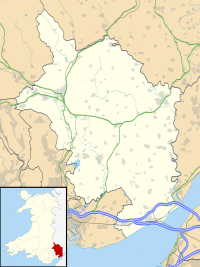
Back Raglan Castle CEB Castell Rhaglan Welsh Raglan Castle Danish Raglan Castle German Raglanin linna Finnish Château de Raglan French Raglan Castle Italian Raglan Castle NB Castelo de Raglan Portuguese Раглан (замок) Russian
| Raglan Castle | |
|---|---|
| Monmouthshire, Wales | |
 Raglan Castle, main gatehouse, south-east front | |
| Coordinates | 51°46′13″N 2°51′08″W / 51.7703°N 2.8521°W |
| Grid reference | grid reference SO413083 |
| Site information | |
| Owner | Duke of Beaufort |
| Controlled by | Cadw |
| Open to the public | Yes |
| Condition | Ruined |
| Site history | |
| Materials | Redbrook Sandstone, Old Red Sandstone, Bath Stone |
| Battles/wars | Siege of 1646 during the First English Civil War |
Listed Building – Grade I | |
| Designated | 19 November 1953 |
| Reference no. | 2101 |
| Designated | 9 February 1948 |
| Reference no. | MM005 |
| Designated | 1 February 2022 |
| Reference no. | PGW(Gt)42(MON) |
| Listing | Grade I |
Raglan Castle (Welsh: Castell Rhaglan) is a late medieval castle located just north of the village of Raglan in the county of Monmouthshire in south east Wales. The modern castle dates from between the 15th and early 17th centuries, when the successive ruling families of the Herberts and the Somersets created a luxurious, fortified castle, complete with a large hexagonal keep, known as the Great Tower or the Yellow Tower of Gwent. Surrounded by parkland, water gardens and terraces, the castle was considered by contemporaries to be the equal of any other in England or Wales.
During the First English Civil War, Raglan was occupied by a Royalist garrison on behalf of Charles I but was taken by Parliamentarian forces in 1646 and its walls slighted, or deliberately put beyond military use. After the Stuart Restoration in 1660, the Somersets declined to restore it and it became first a source of local building materials, then a romantic ruin. It is now a tourist attraction.
